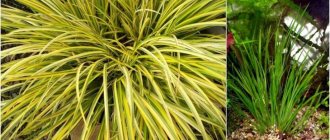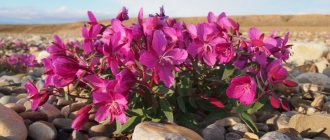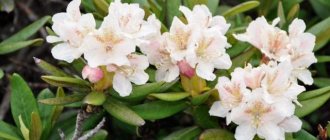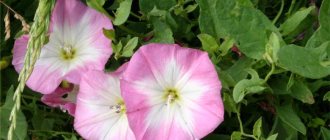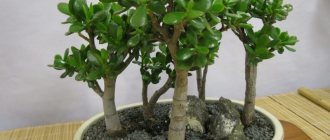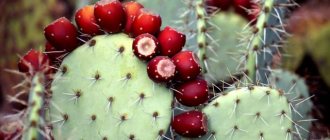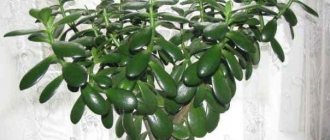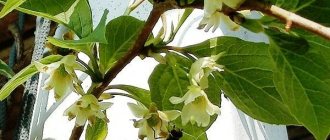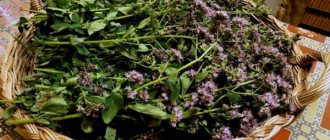- October 13, 2019
- Flowers
- Lyudmila Antonova
Evading peony (Paeonia anomala) is a perennial herbaceous plant of the Peony family. Another name is Maryin root or Maryin grass. The plant was first bred in the 18th century.
After its appearance, the plant could be found exclusively in botanical gardens. Currently, the Maryin root flower is actively used in the field of medicine and cosmetology. It is distinguished by its resistance to adverse conditions.
In this article we will study in detail how to plant the Maryin root flower and the care that the plant needs, and also consider the signs and properties of the plant.
Botanical description of the plant
When starting a conversation about Maryin root, planting and caring for the plant, we should talk about the botanical characteristics of the flower. This is necessary in order to have a complete understanding of the flower and understand what conditions it will need for optimal growth and development.
To make a botanical description, you should carefully look at the photo of the Maryina root flower.
This is a large plant, the length of its stems can reach one meter. The root system of the Maryin root flower consists of a massive tuberous rhizome with numerous fleshy brown adventitious roots. The inside of the root is light and has a specific smell. Sometimes the root of an adult plant weighs 5-6 kg, as it tends to store nutrients and moisture. Peony root is valued in the medical field.
Looking at the photo of the Maryina root, we can conclude that the stems of the plant are hard, thick, erect, single-flowered, and have leathery scales at the base. The leaves are compound, alternately arranged, large (up to 30 cm in length, 2.5 cm in width), with petioles. By autumn they change color from green to dark red.
The Maryin root flower is single, large, can reach 14 cm in diameter, and has a double perianth. The corolla consists of five purple-pink petals. The number of pestles is usually from 2 to 5 pieces. Stamens are numerous. The calyx consists of five green leaves. Maryina grass begins to bloom early. During drought and heat, the flowering period is reduced.
In August, the formation of the fetus occurs. The fruits of the plant are multi-seeded star-shaped leaves, which, when ripe, open along the length of the ventral suture. The seeds have a slight shine and black color.
Growing a flower, how to plant it correctly in open ground
Peony Sorbet (Paeonia Sorbet) - growing in the garden
Red peony is easy to grow. It is enough to carry out a standard set of procedures.
Planting with root cuttings
Suitable cuttings are taken only from mature bushes. To do this, the plant is carefully removed from the soil and cleared of the earthen clod. Divide the root system into the required number of parts. But each must have its own roots, as well as at least 2 buds. After this, each part is planted in a separate hole in the traditional way.
The roots of an adult plant must be divided into several parts.
What time does boarding take place?
The ideal time to plant marina root is autumn. Grows at home and in open ground.
Additional Information! If planting is carried out on the site, then it is carried out 45 days before the onset of the first frost. The seedling has enough time to take root thoroughly.
Selecting a location
Peony is a wild flower. Undemanding to the composition of the substrate. External conditions are not very important for him. It grows well in full sun and shaded areas.
It is better to keep house flowers away from heating radiators. They can dry it out and cause diseases. It is better to choose a place that will be protected from strong drafts. The bush will take root well under garden trees if planted in open ground.
How to prepare the soil and flower for planting
Before planting, it is necessary to prepare planting material. To do this, the roots are dried, after which the sections are sprinkled with crushed wood ash.
Planting holes require preparation. The ground where they will be located should be dug up and a mixture of superphosphate, sand and potassium should be added to it. These substances will give the substrate the necessary looseness.
Step by step landing procedure
The seedling is planted in a previously prepared hole. Experienced gardeners recommend adhering to the following instructions:
- Make holes, the depth of each should be 2 shovels, and the diameter should be 50 cm. The bottom is covered with a drainage layer.
- Lay out a nutrient substrate, which includes sand, garden soil, and humus. The plant is placed in the center so that the roots are not tangled or intertwined.
- The soil is poured on top and lightly compacted. At the very end, the seedlings are watered abundantly.
- They also install a support near the bush and tie the stems to it so that they do not bend or break.
Note! During the first few years, stepsoning is required. Only in this case will the young plant be able to develop correctly and fully.
Planting by seeds
The seed planting method is not so popular among gardeners. This is because the process takes a lot of time. First, they are stratified in a special tank filled with wet sand. Usually the period lasts 40-45 days. The temperature in the container must be maintained at +20 ℃.
Then the seed material is put into the refrigerator for 5 months. After this, they are laid out on a sunny windowsill and wait for the shoots to appear. During this period they are moistened. Seedlings are planted in open ground for the 3rd year.
Tales of Peony
Maryina grass has been known since ancient times. Mention of it can be found in many legends. There is an interesting myth about the name of peony. In Ancient Greece there lived a talented doctor and his name was Paean. He skillfully treated both the Olympian gods and people. He did it so well and saved so many lives that Paean's teacher began to envy him. The teacher, obsessed with envy, decided to poison his student, but at the right moment the gods came to the rescue and turned Paean into a beautiful bush strewn with flowers. Since then, this bush has been called a peony, and it continues to help people in the fight against diseases and illnesses, and photos, care and planting of the Maryin Root flower are important sections of many botanical books.
Maryin root was also endowed with magical powers. It was believed that he could ward off poisonous snakes and evil spirits, and also heal the possessed. Where there is a flower, evil spirits do not dare to show themselves. Necklaces and amulets were made from it. It was believed that replanting and digging up a plant could only be done at night, otherwise you could lose your eyesight. Girls who dreamed of getting married believed that if you grow a peony bush in the garden, you will definitely meet your future husband. And married couples were recommended to put peonies in the bedroom in order to rekindle their former passion.
Spreading
Maryin root is a rare species with a certain distribution zone. Peony can be found in Russia (Siberia, the Urals, Perm Territory and the Komi Republic), China, Mongolia and Kazakhstan. The Mongols call it “purple peony”, the inhabitants of the Middle Kingdom call it “Xinjiang Peony”. In some areas, the plant is listed in the Red Book, and a photo of the Maryin Root flower is presented in botanical museums for clarity. After all, everyone needs to know what a rare plant looks like in order not to pick a flower while walking through the forest.
Plant of the Ranunculaceae family
A representative of this particular family is marin root. In addition to this name, the plant has others:
- evasive peony;
- extraordinary peony.
However, no matter what you call it, Maryin root very clearly exhibits medicinal properties, reviews of which are simply thundering.
The plant belongs to the buttercup family, the class of dicotyledons. Very beautiful, has spectacular and large leaves, blooms magnificently with bright flowers. Popular as a decoration for garden plots. Unpretentious, easy to grow and care for. Maryin root, the photo of which is presented in this article, is an example of a harmonious combination of beauty and benefit.
Maryin root: planting and care during vegetative propagation
The process of vegetative propagation is carried out by dividing the rhizome of the plant. It is necessary to divide it so that each part contains roots and buds. Cuts on the divided parts should be treated with charcoal powder and air dried. After this, the blanks are placed in recesses 50 cm deep, filled with a mixture of garden soil, sand and black soil with the addition of potassium salts and superphosphates. The empty space is filled with fertilized soil and moistened abundantly. For healthy growth, Maryina root needs space, so there should be a distance of more than 70 cm between plants.
As a rule, it is in the fall that the Maryina root is planted; care at this time should be special. It is necessary to ensure that the cuttings do not freeze. The plant quickly takes root and easily adapts to new conditions. It should be expected that the plant will not produce flowers in the first season.
Caring for the Maryina grass plant
Peony is easy to care for and does not require any serious intervention. Even under such conditions, a healthy bush grows, which will delight the owner with beautiful and abundant flowering.
Watering and fertilizing
Peony Rosea Plena (Paeonia Rosea Plena) in the garden plot
The plant does not require frequent moisture. This is explained by the fact that moisture accumulates in its tuberous root system. During the growing season, procedures are carried out once every two weeks. For an adult bush, take two buckets of water. It is impossible to over-water the flower, as the roots may rot.
As for fertilizing, mineral complexes are ideal for young bushes. They are applied once every 1-1.5 months. An adult plant is fertilized with the onset of spring; urea is perfect for this. Then, until autumn, three more mineral applications are carried out.
Mulching and loosening
Do not allow the flower to become overgrown with weeds. Loosening is carried out on a regular basis. This is done after watering activities or after rain. The depth is approximately 10-15 cm.
It is important to know! Mulching is done only in the first year of planting a seedling. A mixture containing peat, humus, and sand is poured around the bush. All components are taken in equal proportions.
Preventative treatment
Preventive treatment is carried out to avoid problems, in particular the emergence of diseases and pest attacks that can harm the crop. Fungicidal preparations are perfect for this. The bushes are sprayed with solutions. As an additional measure, spill the soil with Bordeaux mixture.
Maryin root: propagation by seeds
In nature, Maryina grass reproduces by self-sowing. If you want to grow your own grass in the garden, you will have to work hard. Plants are not able to germinate quickly, which is due to their thick shell. The process, although not easy, is quite interesting.
So how to grow Maryin root from seeds? To begin with, the collected seeds must undergo pre-treatment:
- First stage. Place the seeds in soaked sand or on soaked cotton pads. The ambient temperature should be about +20-25 degrees Celsius. The duration of the first stage is 2 months. During the first stage of planting Maryina root, caring for the plant must be very careful. During this period, you need to monitor the seeds, maintain constant humidity and make sure that mold does not form. It will be most convenient to place the seeds on a tray, Petri dishes or ordinary plates.
- Second phase. After a couple of months, the seeds must be placed in a cool place with a temperature of +3-4 degrees Celsius. You can use the refrigerator. At this stage, it is worth moistening the Maryin root flower seeds once with a 0.1% solution of potassium permanganate. This procedure is carried out in order to avoid the formation of fungal infections. This period lasts a couple of months and should end with the emergence of seedlings.
- Third stage. After this, the seedlings are planted in pots, which are placed in a sunny but cool place. To obtain good seedlings, you can use phytolights. You also need to constantly feed and water young plants. It is recommended to use Gummi fertilizer three times during the growing period of seedlings. The first time was two weeks after landing, a month later - the second time, a month and a half later - the third time. This stage will last two to three months. When the seedlings are strong enough, the plant is planted in open ground.
Planting and caring for Maryina Root is a fairly simple task that even a novice gardener can handle. The plant is not picky; caring for this representative of the flora is not difficult.
Growing from seeds
Under natural conditions, the extraordinary peony reproduces by self-seeding (except for places where the seeds do not have time to ripen). Shoots may appear in the spring or delay for 1-2 years. Growing a flower from seeds at home will require a lot of time and patience. You can't count on flowering soon. Poor seed germination is due to the durable shell. To activate growth, stratification is used - alternating exposure to heat and cold.
Advice. Start collecting seeds before they are fully ripe, but not earlier than mid-August. Their shell is softer and lighter.
The seeds of the evasive peony are brown, smooth and elastic. Size 0.5-1 cm. They are sown immediately after collection in open ground or prepared containers with substrate. In nature, seeds undergo a natural process of stratification; at home, it is created artificially. In the first year after wintering, plants take root. Leaves and shoots will appear only after a year. During the cold period, the beds with seeds are mulched with straw and dry leaves. In cold regions, they are additionally covered with spruce branches.
Choosing a landing site
An important role is played by the place where the Maryina root will be planted and cared for. The flower cannot be grown close to buildings and trees, since the plant prefers spacious and free areas. Also, before planting, you should make sure that there is no groundwater in the chosen location. If they are present, the plant will die. In areas where precipitation accumulates, the plant will also not be able to survive. Loose soil enriched with mineral and organic substances is perfect for peony.
1.Seven secrets of success:
| 1. Planting and care: peony is planted in open ground in late August - early September, selecting an area with fertile soil and direct sunlight in the morning. |
| 2. Peony care: plants will need timely watering and fertilizing, as well as weeding and loosening the soil. |
| 3. Beneficial properties: in homeopathy and folk medicine, tincture of the root is used as a sedative. |
| 4. When it blooms: depending on the variety, flowering may occur in May - June. |
| 5. Feeding: peony loves both organic and mineral fertilizers and for abundant flowering the plants should be fed 3-4 times a year. |
| 6. Transplantation: you should not replant unless absolutely necessary if the plant has existed in the same place for more than 10 years. Transplantation is most often used to propagate a flower. |
| 7. Reproduction: varietal plants are bred by sowing seeds, and on the site it is better to propagate peony by dividing adult bushes. Some varieties and varieties are propagated by cuttings of rhizomes. |
Botanical name: Paeonia.
Family. Peony.
Origin, where it grows. In nature, peonies can grow in completely different conditions - for example, in meadows, small undergrowth or in mountainous areas. Plants are found in East Asia, Europe and North America.
Watering
It is not recommended to water Maryin root frequently, as waterlogging can cause the plant to rot. But this does not mean that you should ignore watering. It is advisable to irrigate the burnt grass once every 7 days. Each bush consumes about 10-20 liters of water. It is very important to water the plants in early spring, as flowers form at this time, and also in August, when buds begin to form. After irrigation, loosening the soil will have a beneficial effect on the plant. This is required for air exchange. After loosening the soil, it is recommended to get rid of weeds that interfere with the growth of the peony.
Advantages of the evasive peony: ↑
- Shade-tolerant species. Grows well in partial shade. A real find for forgotten corners of the flower garden and areas near trees!
- It can grow and develop on clay soil, but does not like wetlands.
- The roots are able to retain a supply of water for a long time, so there is no need to water the bushes often.
- Very frost-resistant species. The plant does not need pruning - the stems will die off on their own and are removed with a rake in the spring, and the roots do not require shelter for the winter.
- Blooms a month earlier than varietal peonies!
Fertilizers
After planting, the Maryin root should not be left - care should include the introduction of fertilizers. It is better to fertilize young plants using the foliar method: it is recommended to irrigate the plant once a month with a solution of mineral fertilizer (Ideal is perfect) from a watering can. For a greater positive effect, add a soap-based solution. The best time for the procedure is the end of the day.
Adults are fed 3 times, every month. Fertilize the plants with a solution consisting of urea and water with the addition of organic elements. It is most effective to fertilize mature, strong plants at the root.
Each period of growth requires certain chemical elements: nitrogen - at the beginning of the growing season, during the formation of the inflorescence and active flowering - calcium, nitrogen and phosphorus, and when the plant forms buds - phosphorus and potassium are necessary.
Chemical composition[ | ]
The active substances are concentrated in the root of the plant, in which essential oils, free salicylic and benzoic acids, methyl salicylate, trace elements [2], flavonoids, saponins, tannins are found [ source not specified 71 days
], about 1.5% essential oil, traces of alkaloids, glycosides - paeoniflorin and other iridoids, which apparently determine the medicinal effect of the plant [11].
According to one analysis, tuberous roots contained the following percentages: moisture 1.3, ash 6.23, resin 1.62, essential oil 1.59, salicylic acid 0.36, sugars 10.0, starch 78.5, non-hydrolyzable substances 2.1%[13][3].
According to one source, the aerial parts and roots do not contain alkaloids[14]. According to another source, the roots contain a small amount of them[15]. Another source did not find alkaloids in the leaves, but found traces of them in the stems and roots, and in another sample no alkaloids were found in the roots[16]. Thus, the content of alkaloids in marina root varies depending on the location and growing conditions [3].
Application in medicine
This representative of the flora is known for its rich content of organic and mineral components that have a beneficial effect on the human body. It is intensively used in medicine.
Medicines based on parts of the Maryina root have analgesic, anti-inflammatory, bactericidal, expectorant, sedative, and tonic properties, and also normalize blood pressure, increase immunity, reduce appetite, reduce aggression, improve sleep and generally have a positive effect on the central nervous system and mental health person.
Another property is stimulation of the production of endorphins or happiness hormones.
Maryina grass is also used to improve the health of the female body. During menopause, this tincture helps to cope with its consequences.
The plant helps fight anxiety, mood swings, depression, relaxes and calms. It is recommended to take peony-based tincture to regulate the monthly cycle and relieve menstrual pain. Also, the herb, in combination with other medications, fights such neoplasms in women as fibroids and cysts.
The use of tincture has a beneficial effect on men. It is a highly effective remedy for restoring potency.
Tinctures are perhaps the most popular medicine produced from Maryina root. They are usually made with water and alcohol. Also popular are decoctions prepared from the peony Maryina root. At the pharmacy you can buy a dry extract from this healing representative of the flora.
The underground and herbal parts of peony are used to make medicines. These parts are collected during the period of active flowering. Caring for and planting Maryina root for medicinal purposes is no different from planting a plant to decorate a garden.
Popular traditional medicine recipes
To prepare a tincture with alcohol, you will need 60 g of pre-dried rhizome, which must be poured with a strong alcoholic drink (vodka or alcohol is often used). The root is infused for three weeks, enriching the liquid with useful substances, then it is filtered and taken for one month. This tincture helps get rid of anxiety, stress and insomnia, and also improves the general condition of the body. In ancient recipes they wrote about the property of the tincture to fight infertility.
To obtain a decoction for the treatment of gastrointestinal diseases, take 15 g of well-crushed parts of the root system of the zhgun-grass and pour boiled water. The solution is boiled over low heat for 9 minutes. When the mixture cools, it is filtered. It is advised to take the decoction 20 minutes before meals, three times a day.
To obtain a strengthening tea drink, you need to brew several petals of the Maryina root flower in one glass of boiled water. The resulting tea is taken 2 times a day. The drink stimulates the immune system; in cold weather, tea is taken to avoid colds.
Requirements for growing conditions for peony evasive
It can grow in the most shaded place in the garden and still bloom luxuriantly. In the second half of May, the bush looks like a huge bouquet consisting of 20–30 large (from 10 to 18 cm in diameter) flowers.
It reproduces well, very rarely suffers from gray rot and is durable. With proper care, it can grow in one place for 25 to 50 years.
Is it poisonous?
Despite the fact that peony is so valued in medicine and many medicines are made from its parts, Maryin root is still a poisonous plant. There are certain contraindications to its use. Therefore, it is not recommended to take medicines made from the root without consulting a doctor as it may adversely affect your health. Be sure to consult a specialist before starting treatment.
Remember: evasive peony is a toxic plant. People with low blood pressure, kidney failure or individual intolerance should be wary of using such medications. People suffering from gastritis and high stomach acidity should not take the drug. To avoid side effects and allergies, it is forbidden to increase the dose and time of treatment. When the dosage is higher than normal, the central nervous system is suppressed. The use of medicines from Maryina root is also contraindicated for children and pregnant women.
Properties of marina root: benefits and harms
Maryin root is a medicinal plant. Like any medicine, if used incorrectly, it can cause harm. It is worth paying close attention to the recommendations and rules of use for therapeutic purposes.
Medicinal properties of marina root
The healing qualities of Peony irregular have been confirmed over the years. It contains such useful substances as:
- tannins,
- ethers,
- resins,
- flavonoids,
- Sahara,
- sterols,
- saponins,
- acids (salicylic, gallic)
The healing effects of marina root on the body:
- improvement of metabolism,
- detoxification of the body;
- eliminating the feeling of constant fatigue and stress;
- general strengthening of the nervous system;
- recovery after binge drinking;
The substances found in the plant contribute to the production of a hormone familiar to everyone, responsible for a good mood, a feeling of happiness and even euphoria - endorphin. In addition, they are used for headaches, gastrointestinal problems, nervous disorders, asthma, etc.
Maryin root has a therapeutic effect on the female and male reproductive system. Helps even with infertility.
A tincture is made from the plant, which copes well with chronic fatigue, anxiety, and bad mood.
You can also make cosmetics to cleanse the skin. For example, it perfectly fights acne and other skin inflammations.
EVADERING PEONY || Useful properties and applications
Contraindications
Maryin root is poisonous. And this must be remembered before use. Especially when there are health problems and a person takes medications for a long time. Allergic reactions and intolerance to certain substances are possible. The use of marina root is contraindicated for anyone who suffers from high blood pressure, as well as for those who have increased levels of acid in the stomach. It is forbidden to take by pregnant women and children under 12 years of age.
In any case, you should consult a doctor before use, regardless of your health condition.
Peony marin root is an interesting and useful plant. It is valued for its healing properties. The spectrum of action is wide. It can be purchased at the pharmacy, already processed, and you can collect and dry it yourself. To do this you need to know the rules on how to do this.
Garden flowers Perennial flowers
Use in cosmetology
Zhgun-grass contains many useful components, therefore it is used in cosmetology. The plant has been used in the beauty industry for many years.
The herb strengthens the hair roots, activates their growth, gives a healthy glow and helps reduce the secretion of oil and dandruff on the head. It is recommended to rub diluted infusions (not alcohol) into the scalp. It is also useful to add the infusion to water to rinse your hair.
Due to the fact that Maryin root contains essential oils, it is an excellent component of face creams. Its extract helps fight skin aging, and therefore is used to make creams and emulsions aimed at combating aging.
Infusions prepared from Maryina root are effective in the fight against acne and blackheads, since they contain salicylic acid. It is this that acts as a disinfectant on oily skin and dries it out. For some dermatological ailments it is used to heal wounds.
Evading peony (Paeonia anomala L.)
Syn.: extraordinary peony, irregular peony, marina root, marina grass, heart berries, shegnya, etc.
Perennial herbaceous rhizomatous plant. It is known in culture as an excellent ornamental and valuable medicinal plant.
In medicine
Contraindications and side effects
There are almost no categorical contraindications for the use of peony evasive tincture, except for hypersensitivity to the components of the drug, pregnancy and breastfeeding, as well as in childhood (up to 12 years).
It is recommended to take peony preparations with caution in case of increased stomach acidity, low blood pressure, kidney disease, alcoholism, brain diseases and traumatic brain injury. Peony tincture can cause some lethargy, so doctors do not recommend driving a car after taking it.
In large doses, peony is poisonous, so the duration and regimen of taking medications based on it should be determined by the attending physician.
In cosmetology
In cosmetology, peony evasive is used to rejuvenate the skin and give it elasticity, to strengthen hair, and also to eliminate dandruff. Peony essential oil is one of the components of anti-aging cosmetics.
In other areas
Peony evasive is currently being used in various fields. First of all, it serves as a raw material for making tinctures. In cooking, it is used to prepare seasonings and drinks; for example, peony is part of the Baikal tonic drink. In Mongolia, peony is brewed as tea.
The evasive peony has been in cultivation since 1788. It is grown in gardens as an ornamental plant that perfectly complements flower arrangements. The plant is also grown for medicinal purposes.
Classification
Evading peony (Latin Paeonia anomala) is a species of the only genus Peony (Latin Paeonia) of the Peony family (Latin Paeoniaceae). The genus includes about 40 species of mostly perennial rhizomatous herbs, distributed throughout the Mediterranean, as well as in temperate and subtropical regions of Asia. There are about 15 species on the territory of Russia, of which several species are endemic to the Caucasus, and one species is endemic to the Crimea.
Chemical composition
The chemical composition of the evasive peony has not yet been sufficiently studied. The roots contain up to 1.6% essential oil, which includes: peonol, methyl salicylate, benzoic and salicylic acids, as well as up to 30% carbohydrates (especially starch, glucose, sucrose), ascorbic acid, salicin glycoside, tannin and a small amount of alkaloids . Ascorbic acid is also found in leaves (0.3%) and flowers (up to 1%). Up to 27% fatty oil was found in the seeds.
Use in folk medicine
In folk medicine, peony evasive is used quite widely.
The use of peony preparations in folk medicine is somewhat limited due to its recognition as a poisonous plant.
Historical reference
There were also legends in Armenia that the peony, Mary’s root, was capable of expelling dark forces from a person. To cure gout and suffocation in Western Europe, peony flowers were applied to the heart. In ancient times, the roots and petals of plants with red flowers were used. Dictionaries mention several more names of the plant - marina grass, heart berries, shegnya, etc.
Literature
1. Andreeva V.N. et al. Paeonia anomala L. – Maryin root peony // Biological flora of the Murmansk region / Executive editor N. A. Minyaev. Apatity: Kola Branch of the USSR Academy of Sciences, 1984. P. 4-32.
2. Atlas of medicinal plants of the USSR / Ch. ed. N.V. Tsitsin. M.: Medgiz, 1962. P. 87-89.
3. Blinova K. F. et al. Botanical-pharmacognostic dictionary: Reference. allowance / Ed. K. F. Blinova, G. P. Yakovleva. M.: Higher. school, 1990. P. 223.
4. Grinkevich N.I. and others. Medicinal plants: A reference guide. / Ed. N.I. Grinkevich - M.: Higher School, 1991. - 398 p.
5. Zamyatina N.G. Medicinal plants. Encyclopedia of Russian nature. M. 1998. 485 p.
6. Chikov P. S. Atlas of areas and resources of medicinal plants of the USSR. M.: Cartography, 1983. 340 p.
Use in cooking
In addition to its widespread use in cosmetology and medicine, its use in cooking can be added to the description of Maryina root. The underground part of the grass is edible. In wartime, it was used as food (boiled, fried and baked), and flour was also made from the root. Nowadays, Maryin root is most often added to dishes as a seasoning. In some regions of Kazakhstan, porridge is cooked from it. Tea prepared with the addition of this plant is also popular.
Having looked at the photo and description of the Maryina root, we can say that this is an amazing and beautiful flower that plays a significant role in different areas of human life.
Title[ | ]
Species name "evader" - translation of the Latin anomalia
, from ancient Greek. ἀνωμᾰλία “deviation”, “incorrectness”. This is believed to be due to the fall color of this type of peony, which distinguishes it from other species.
Vladimir Dahl's Explanatory Dictionary of the Living Great Russian Language and Annenkov's Botanical Dictionary mention several more names of the plant - marina grass
,
heart berries
[8],
shegnya
[9] (
Tschegna
).
The latter may be of Mongolian origin. In the Great Soviet Encyclopedia (2nd edition) the name Chechna
[4].
